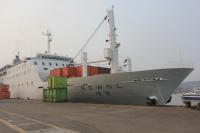 The death toll in the sinking of the Korean passenger ro-ro ferry Sewol has risen to 171 with 130 still missing. The ferry capsized and sank in the Yellow Sea last Wednesday, April 16th, on a voyage from Incheon to the island of Jeju. Of the 476 passengers and crew aboard, 325 were high school students on a four day field trip.
The death toll in the sinking of the Korean passenger ro-ro ferry Sewol has risen to 171 with 130 still missing. The ferry capsized and sank in the Yellow Sea last Wednesday, April 16th, on a voyage from Incheon to the island of Jeju. Of the 476 passengers and crew aboard, 325 were high school students on a four day field trip.
There have been recent reports that the ferry was overloaded. Overloading has contributed to similar ferry disasters. When the Korean ferry Seohae sank in 1993, with the loss of 292, it had been carrying 362 people — 141 passengers and crew in excess of its rated capacity of 221. At least in terms of passengers, this was not the case on the Sewol’s last voyage. There were 476 passengers and crew aboard, well below its rated capacity of more than 900 passengers and 36 crew.
There have been claims that cargo aboard the Sewol was overloaded. It is hard to know what to make of the reports. The Wall Street Journal reports that “just before departing the port of Incheon on Tuesday last week, the ship, the Sewol, reported by radio to the Korea Shipping Association that it was loaded with 3,608 tons of cargo. The maximum recommended weight of cargo for the Sewol was 987 tons, an official at Korean Register said on Wednesday.” The Sewol had a reported deadweight of 3,794 tons, so the reported cargo figure would only allow 186 tons for passengers, fuel, ballast, and ship’s stores. It is possible that the ship was loaded deeper than its loadline, though that seems unlikely. It is unclear what the quoted figures refer to or whether they are in any respects comparable.
Adding to the confusion, the Korea Herald reports that the ship owner, Chonghaejin Marine, told authorities at the Korea Shipping Association that the Sewold had 450 passengers, 24 crew members, 150 vehicles and 657 tons of cargo on board when it sailed.
After the sinking the company said that the actual figures were 477 people, 180 vehicles and 1,157 tons of cargo. The 1,157 tons of cargo may refer to the containers stored on foredeck of the ferry in front of the deck house. The company subsequently corrected the number of passengers and crew to 476 people. According to the report, the Sewol had a legal capacity of 921 passengers, 180 vehicles and 154 regular cargo containers.
The Korea Herald also reports: However, heavy trailer drivers carrying more than 30 tons of materials each, said the actual freight could be even heavier. Heavy vehicles and their loads weren’t examined before they were loaded on the Sewol,” another truck driver told reporters. “Because the Sewol is lax when it comes to overloading, many cargo owners prefer taking the Sewol than to drive all the way to Mokpo in South Jeolla Province and take a ship there,” he added.
The increased weight of vehicles in the hold would have increased the ferry’s stability, making it less likely to capsize. On the other hand, if the vehicles were not properly secured and shifted when the ferry rolled, the increased weight could have resulted in a serious list which may have lead to the capsize.
There is also considerable discussion about the extending of the ship’s upper decks to add passenger capacity in 2012. The modifications added 239 tons of steel high in the ship and raised the center gravity of the vessel. The work was done with the approval of the Korean Register of Ships (KRS) and resulted in requirements that the ship carry sufficient ballast water to maintain the required stability. The KRS is currently investigating whether the ship was operated with the necessary ballast.
